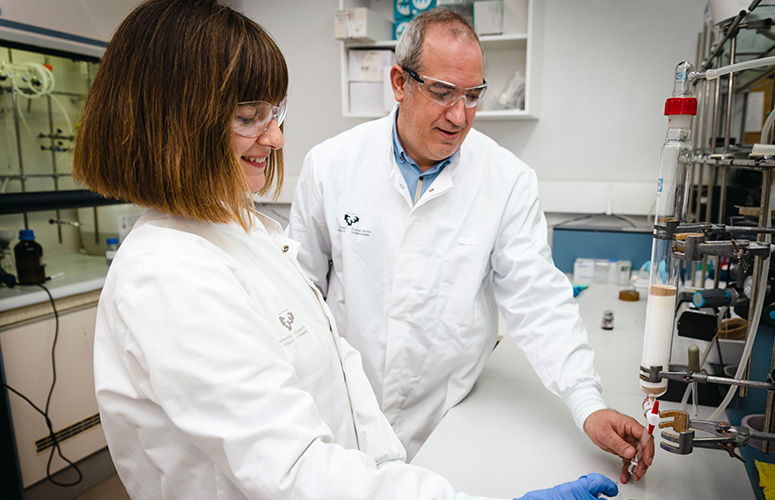The groups led by UPV/EHU professor José Luis Vicario and University of Zaragoza professor Pedro Merino are together exploring the generation of polycyclic compounds (those with more than one ring made up basically of hydrogens and carbons) with direct applications in the pharmaceutical industry. The methodology used as well as the usefulness of the compounds obtained have merited recognition by the journal Chemistry: A European Journal published by Wiley-VCH.
-

Ferreirak eta Bengoetxeak beren programak aurkeztu dituzte UPV/EHUko Klaustroan
-

UPV/EHUko 19 diziplina, munduko 500 onenen artean, Shanghaiko rankingaren arabera
-

Zientzia, Ingeniaritza eta Arkitekturako monografiarik onena
-

Medikuntza birsortzailearen etorkizunari buruzko gakoak
-

Beste pertsona bat al gara beste hizkuntza bat hitz egitean?
Advances in drug synthesis “through Alice's looking glass”
Research by the University of the Basque Country (UPV/EHU) and the University of Zaragoza features on the front cover of the research journal Chemistry: A European Journal
- Research
First publication date: 27/12/2022

“How would you like to live in Looking-glass House, Kitty? I wonder if they’d give you milk in there? Perhaps Looking-glass milk isn’t good to drink.” Lewis Carroll already imagined in 1871 that objects contained in the reflection of a mirror might not have the same properties as “real” objects. The fact of observing two images of the same object, one of them a reflection of the other, led Alice to consider this idea in the book “Through the Looking Glass and What Alice Found There”; and it was famous scientists, such as Pasteur, who had the opportunity to demonstrate it in their laboratories through the study of the molecules that make up matter: the images of the molecular structures of tartaric acid (present in many fruits, especially grapes) on both sides of the mirror turned out not to be superimposable (i.e. they cannot be superimposed, as is the case with a person's two hands) and also had different properties. These molecular structures are known as tartaric acid enantiomers.
It is now known that in therapeutic targets, on which a drug exerts its action, only one of the two mirror images (the molecular structure of one side of the mirror) or enantiomers of a drug are needed to achieve the desired effect. The potential side effects that may be caused by the opposite enantiomer, the milk in the reflection in Lewis Carroll's story, are also reduced or even eliminated. At the Faculty of Science and Technology the Asymmetric Synthesis, Sustainable Chemistry and Biomimetic Processes Group led by the UPV/EHU professor José Luis Vicario has been working for more than two decades on the discovery of new methodologies geared towards the preferred preparation of a single enantiomer for synthesising different drugs and natural products of therapeutic interest.
A single enantiomer is generated from the two possible enantiomers
In collaboration with Professor Merino of the University of Zaragoza, they have recently developed a novel way of creating polycyclic compounds: in a way analogous to that by which two rings can be generated from one ring when the two ends of its diameter are joined together. The Asymmetric Synthesis, Sustainable Chemistry and Biometric Processes Research Group has succeeded in carrying out this operation on a molecular scale by means of catalysis and generating a single enantiomer from the two possible ones.
The methodology used in this research as well as the usefulness of the compounds obtained have merited recognition by Chemistry: A European Journal published by Wiley-VCH within the field of multidisciplinary chemistry. The authors were invited to design the front cover of the latest issue (https://chemistry-europe.onlinelibrary.wiley.com/doi/10.1002/chem.202203257) in which Alice is depicted going through the mirror about to become her enantiomeric form (her mirror image) and meeting a catalyst that accompanies her down the yellow path to form the final product, a sulphonamide.
Additional information
Dr Vicario lectures in the Master's and PhD Synthetic and Industrial Chemistry programme and is the senior researcher of the Asymmetric Synthesis, Sustainable Chemistry and Biometric Processes Group of the Department of Organic Chemistry II at the UPV/EHU’s Faculty of Science and Technology.
Bibliographic reference
- Brønsted Acid versus Phase-Transfer Catalysis in the Enantioselective Transannular Aminohalogenation of Enesultams
- Chemistry: A European Journal
- DOI: DOI: 10.1002/chem.202202267


